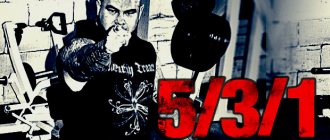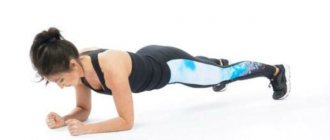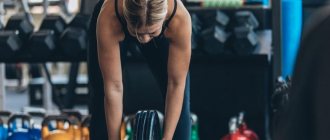Joe Weider , the “ king ” of bodybuilding and the teacher of future world celebrities, can say with confidence that he has achieved everything in this life. Over the course of his long professional career, Joe has developed training principles and rules. Vader also introduced everyone to his training methodology - the Body Building System.
Biography
Joe Weider was born on November 29, 1919 in Montreal. He started training at an early age. The design of his first boom consisted of automobile wheels and a locomotive axle.
At age 17, Joe published Your Physique magazine. It talks about Joe's own training methods and how to build muscle the right way. Afterwards the magazine will be renamed “Muscle Builder”, and even later “Muscle & Fitness”.
After the war, Joe Weider and his brother Ben began actively promoting bodybuilding. The Weider brothers became the founders of the International Federation of Bodybuilders in 1946. 19 years later, Joe founded the Mr. Olympia competition, which is still the most significant competition for bodybuilders. These competitions were created to continue the training of athletes who won the Mr. Universe competition.
Joe Weider trained such famous bodybuilders as Arnold Schwarzenegger, Frank Zane, Lee Haney, Larry Scott, Franco Colombo and Louis Ferrigno. As soon as bodybuilding gained popularity among women, Weider created the Miss Olympia competition. The first competitions in women's sports took place in 1980. Joe Table's other accomplishments include founding Weider Publications, which produces fitness magazines such as Muscle Power, Mr. America, Men's Fitness, Shape, Prime Health and Fitness, Flex, and Cooks." In the late 90s, the publishing house was bought by.
In addition to all of the above, Joe Weider founded a series of books in which he talked about his training methods , called “The Weider Body Building System.”
Bodybuilding Legends: THE STORY OF JOE VADER (RUS Sportfaza)
The rise of bodybuilding occurred in parallel with an increase in interest in physical health in mainstream culture. This has been especially noticeable in the last few years as we have seen many gyms open across the country and sales of sportswear, equipment and nutritional supplements have skyrocketed. During the 1980s, bodybuilding played an increasingly prominent role on television, appearing on three national television networks as well as most cable sports channels. Unfortunately, this interest from the media did not receive worthy continuation in the 1990s. The reason was the numerous discussions about doping and violations of sports ethics. Although many other sports also suffer from problems associated with anabolic steroids, public attention was focused mainly on competitive bodybuilders, who were accused of all sorts of sins. It is clear that this problem must be addressed and attitudes towards bodybuilding must change significantly if bodybuilding is to achieve the success it deserves.
JOE VADER
Any discussion on the topic of bodybuilding would be incomplete without mentioning the contributions of Joe Weider and his Muscle and Health and Flex magazines. Beginning in the early 1940s, Joe published articles with photographs covering bodybuilding competitions. He promoted training methods and listed the main physical characteristics of the most outstanding athletes. In addition, he collected and preserved a huge amount of valuable training material. Joe used his magazines, books and videos to make this information available to the next generation of young bodybuilders.
Over the years, Joe spent a lot of time in gyms, watching the training of bodybuilding stars. For example, in the 1960s, he noticed that Larry Scott used the pulpit machine to develop his biceps, and Chuck Sipes performed series of repetitions at high speed, quickly removing plates from the bar between exercises. He noted these techniques, wrote them down, and then gave them names. Scott didn't call his exercises "Scott presses," and Sipes didn't realize he was using the takedown method, but thanks to Joe Weider, everyone soon had the opportunity to become familiar with these valuable training methods.
Joe Weider with bodybuilders at the 1970 Mr. Olympia awards.
In Austria, I trained in the mornings and evenings because my daily work schedule required it. This type of training is now known as the Weider Double Split System and is used by bodybuilders around the world. The Weider Principles of Training are a collection of the best bodybuilding techniques ever developed by experts. Joe formulated these principles, called them by his own name (for example, the Weider Instinctive Principle, the Weider Priority Principle, the Weider Maximum Compression Principle, etc.) and advertised them in his magazine. It is impossible to count how many bodybuilders have benefited enormously from his ideas regarding training, proper nutrition and everything else that is necessary to achieve success in bodybuilding.
THE EVOLUTION OF MODERN TRAINING
One of the reasons bodybuilders continue to build bigger, denser, more defined muscles is that over the past decades they have developed (mostly through trial and error) better training methods and more effective diets. Over the past fifty years, every sport has undergone significant improvements, and bodybuilding is no exception. In fact, some argue that the level of training has increased in many sports because bodybuilding techniques have become more famous and adapted to different types of training.
In John Grimek's day, bodybuilders trained like weightlifters and worked their entire body no more than three times a week. Now bodybuilders train with a much more complex program. They work out every part of the body more intensively, work the muscles from different angles, and use a wide range of exercises and equipment. In addition, they understand the need to train with relatively short, explosive efforts so that the muscles can then rest, regain strength and increase in volume. Where once the main goal was the overall impression of bulk, now bodybuilders are trying to achieve the highest quality - to create muscles of especially attractive shape and symmetry, where each muscle is defined and separated from the others - a level of perfection that makes modern champions look like a walking anatomy manual.
As bodybuilders developed new techniques, training tools also changed rapidly. The gyms of the 30s and 40s were very primitive by today's standards. Gym owners such as the late Vic Tanney, one of the founders of the modern health club, experimented with different types of pulleys and resistance bands to provide their clients with a wider variety of exercise options. But barbells and dumbbells still occupied a dominant position.
In the early 60s, the advent of exercise machines greatly expanded the possibilities of strength training. Today, Cybex, Hammerstrangs, Bodymasters, Paramount, Universal, Nautilus and many other manufacturers make the exercise equipment absolutely necessary to complement free weight training. Joe Gold, who founded a chain of gyms, designed and built machines so successful that his designs were imitated around the world.
Bodybuilders have also mastered new diets and sports nutrition techniques. Toned and lean muscles have not always been the most important factor in bodybuilding competitions; greater importance was attached to the volume of muscle mass. But then bodybuilders realized that bulk, created mainly by fat cells, has no place in an aesthetic physique. In order to fully demonstrate muscle development, it is necessary to get rid of most of the body fat.
Therefore, bodybuilders stopped increasing pure volume. They began to combine very intense training with a strict diet that included vitamins, mineral supplements and proteins to accelerate development. They studied the effects of steroids, thyroxine and many other biochemical drugs on the body. Finally, they began to use methods of psychological motivation and even hypnosis to ensure that the power of the mind pushed the physical development of the body beyond the limits already achieved. In doing so, bodybuilders attracted the attention of physicians and exercise physiology researchers, who soon recognized that the ability of these athletes to develop the human body represented a true breakthrough in our understanding of strength exercise and its effects on the body. This led to a new revolution in physical culture and the emergence of techniques available to the general public.
A clear sign of the growing popularity of strength training in the United States and around the world is the abundance of good gyms. When I was a beginner bodybuilder and traveled a lot, I often could only find one gym with adequate training conditions. Now, wherever I go, almost everywhere I can find a bodybuilding gym or a health center equipped with the latest technology. Now there are no big differences in the equipment of a professional gym for bodybuilders and a health club for amateurs. People have realized that muscles are always muscles, and you need the same exercise equipment whether you're just trying to stay in shape or winning a Mr. Universe contest.
THE FUTURE OF BODYBUILDING
Joe Weider's set of exercises
A set of exercises for beginners
This program is designed for 2 months of training . Classes are held 3 times a week , without changing or adding anything.
- Press . Starting position: lying down. Raising the body. 2 sets of 20-30 repetitions.
- Barbell bench press . Starting position: lying on a bench. 3 sets of 8-12.
- Barbell row . Starting position: standing with a narrow grip. 2 sets of 8-12 reps.
- Pull of the upper block behind the head . 3 sets of 8-12 reps.
- Dumbbell presses . Alternating raises while standing. 3 sets of 8-12 reps.
- Leg extension . The starting position is sitting on a special machine. 2 sets of 10-15 repetitions.
- Exercises for the triceps muscles . Hand presses down on the upper block. 2 sets of 8-12 reps.
- Exercises for leg muscles . Presses on a special machine. 3 sets of 10-15 repetitions.
- Barbell curl . 3 sets of 10-15 repetitions.
- Calf raises with a barbell on your back in a special machine. 3 sets of 15-20 repetitions.
A set of exercises for intermediate athletes
Monday
- Wide grip bench press 3 sets of 9 reps.
- Standing barbell chest press 3 sets of 9 reps.
- Raising arms with dumbbells while lying head up at an angle of 45 degrees.
- Barbell rows to the chin with a close grip/bent over 3 x 9 reps.
- Standing lateral raises with dumbbells, 3 sets of 9 reps.
- Standing barbell curls 3 sets of 9 reps.
- Raising the torso to the legs from a lying position, 3 sets of 30-50.
- Reclining dumbbell curls on an incline bench, 45 degree angle, 3 sets of 9 reps.
- “French” standing barbell press 3 sets of 9 reps.
- Side bends with dumbbells in hands, 3 sets of 30-50.
Tuesday
- Back squats 3 sets of 9 reps.
- Shoulder Raises with Barbell in Hands Down 3 sets of 9 reps.
- Deadlift 3 sets of 9 reps.
- Leg straightening, sitting on a special machine, 3 sets of 9 repetitions.
- Single leg calf raises 3 sets of 9 reps.
- Wrist curls with an under/overhand grip on the barbell, 3 sets of 30-50 reps.
- Lying leg curls on a special machine 3 sets of 9 repetitions.
- Incline leg raises 3 sets of 25 reps.
Thursday
- Close grip/incline bench press 45 degrees 3 sets of 9 reps.
- Pullover lying over a bench with a dumbbell 3 sets of 9 reps.
- Bent-over dumbbell raises 3 sets of 9 reps.
- Incline barbell bench press 45 degrees/seated overhead 3 sets of 9 reps.
- Bent-over barbell rows 3 sets of 9 reps.
- Seated dumbbell curls with the elbow resting on the inner thigh, 3 sets of 9 repetitions.
- “French” seated dumbbell press, 3 sets of 9 reps.
- Seated dumbbell curls. bench 3 sets of 9 reps.
- Side bends with one dumbbell in hand, 3 sets of 30-50 repetitions.
- Torso raises from a lying position 3 sets of 30-50 repetitions.
Friday
- Back squats 3 sets of 9 reps.
- Extension/bending of legs on a special machine 3 sets of 9 repetitions.
- One-arm dumbbell rows 3 sets of 9 reps.
- Back squats, barbell on back 3 sets of 9 reps.
- Shoulder Raises with Barbell in Hands Down 3 sets of 9 reps.
- Calf raises with a barbell on the back, 3 sets of 15 reps.
- Deadlift 3 sets of 9 reps.
- Torso raises from a lying position 3 sets of 30-50 repetitions.
- Reverse grip barbell curls 3 sets of 15 reps.
- Pulling your knees to your chest while hanging on the bar, 3 sets of 30-50 repetitions.
Joe Weider does not recommend sticking to any preset weights. At times you will have more or less energy during a session and will be able to lift more or less weight.
Joe Weider - Lesson 1 Workout Group Body Structure System Introduction
Training principles
- System of several approaches. This system is performed with each exercise in order to completely exhaust the muscle (group of muscles) being trained, as well as to ensure their stimulation and maximum development.
- The principle of shocking muscles. You should never let your muscles adapt to a training program . In order for muscles to grow, they need to be kept under constant stress. Therefore, it is necessary to change the number of approaches and repetitions.
- The principle of muscle isolation. Muscles can work in isolation from each other. If you want to develop a specific muscle, you need to isolate it from other muscles. This can be achieved using an anatomical position.
- The principle of priority. Give priority to your weakest muscle and start training it first in each session while your energy is at its maximum.
- The "pyramid" principle. You should not start working with heavy weights. The work should start with a small weight, and then go to increase it. Start your workout with a weight of 50% of your maximum and complete the exercise for 15 repetitions. Then increase the weight and do 10-12 repetitions. So increase the weight of the weights to 80%, and repeat the exercises 5-6 times.
- The principle of constructing training cycles. At the initial stage, you prepare a training program and build muscle tissue. At the next stage, it is necessary to increase the number of repetitions and reduce pauses between approaches.
- The principle of "cheating". “Cheating” is not considered as a way to relieve stress from a muscle, but rather to increase it. Therefore, this technique should be used to perform additional repetitions or to help the working muscles by recruiting muscles from another part of the body.
- The "rest-pause" principle. If the weight of your weights is so heavy that you cannot perform more than two or three repetitions, you need to rest your muscles for 30-45 seconds and do a few more repetitions.
- The principle of double division. Most athletes train one or two body parts in the morning and then return to the gym in the afternoon or evening to work a couple more muscles.
These are just a few of Joe Wade's most commonly used training principles.
Weider's training principles.
Training principles for beginners
The principle of progressive loading.
This principle is based on constantly increasing the load in your training. Make your muscles work even harder than they are used to.
This is the basic principle for muscle growth and development in bodybuilding. This is the basis of the training. You need to increase not only the weight of the equipment, but also the number of approaches in the exercise. To train muscular endurance and work on muscle definition, you need to reduce the rest time between approaches.
The principle of shock.
The basis of this principle is to constantly surprise your muscles. Your body should not get used to monotonous workouts. You need to change exercises, angles of impact on muscles, number of approaches, repetitions. When you do this, then each time your muscles will experience stress, which will stimulate the growth of new muscle tissue.
The principle of isolation.
To develop a specific muscle, you need to try to “isolate” it as much as possible.
All this is achieved by changing the anatomical position of the body during the exercise. If you want to isolate your biceps, perform curls while sitting on a curling device or standing against a wall with your elbows touching the wall. Then you will not be able to help yourself lift the barbell by swinging and using your back. You isolate your biceps.
Nutrition
Whatever sport you choose, 60% of success will depend on proper nutrition. Here are three basic rules that must be followed according to Joe Weider :
- It is necessary to carefully monitor the quality of food consumed . It is important that the diet includes all the main components.
- Properly distribute your calorie sources : 60% - carbohydrates . Moreover, it is advisable to eat natural carbohydrates. They give our body the necessary energy that maintains our vitality throughout the day. They are also necessary for restoring glycogen in muscles. 20-25% – plant and animal proteins (preferably with less fat). Protein is needed to produce energy and repair muscle fibers that are stretched during training, and also allows you to build muscle mass faster. 25-30% - fats. They maintain normal blood viscosity. In addition, they promote the production of hormones and the supply of vitamins and energy. In addition to all of the above, in between meals, you need to eat a portion of vegetables and fruits, and also drink 2-3 liters of water per day .
- Nutrition should suit your body type . Beginners need to reduce the amount of fat and, conversely, increase their protein intake.
Igor December 29, 2010
Benefits of the Weider Technique
So, the Vader system:
- Increases muscle strength and endurance.
- Creates an impeccable muscle shape.
- Improves the strength of the musculoskeletal system.
- Improves blood circulation.
- Strengthens overall health.
- Improves speed and coordination.
- Reduces cortisol levels.
- Improves mood.
- Increases self-esteem.
- Helps reduce fat mass.
- Strengthens the cardiovascular system.
- Prevents osteoporosis.
- Increases the level of hemoglobin and red blood cells.











